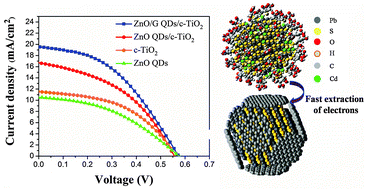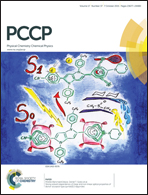Hybrid zinc oxide/graphene electrodes for depleted heterojunction colloidal quantum-dot solar cells†
Abstract
Recently, hybrid nanocomposites consisting of graphene/nanomaterial heterostructures have emerged as promising candidates for the fabrication of optoelectronic devices. In this work, we have employed a facile and in situ solution-based process to prepare zinc oxide/graphene quantum dots (ZnO/G QDs) in a hybrid structure. The prepared hybrid dots are composed of a ZnO core, with an average size of 5 nm, warped with graphene nanosheets. Spectroscopic studies show that the graphene shell quenches the photoluminescence intensity of the ZnO nanocrystals by about 72%, primarily due to charge transfer reactions and static quenching. A red shift in the absorption peak is also observed. Raman spectroscopy determines G-band splitting of the graphene shell into two separated sub-bands (G+, G−) caused by the strain induced symmetry breaking. It is shown that the hybrid ZnO/G QDs can be used as a counter-electrode for heterojunction colloidal quantum-dot solar cells for efficient charge-carrier collection, as evidenced by the external quantum efficiency measurement. Under the solar simulated spectrum (AM 1.5G), we report enhanced power conversion efficiency (35%) with higher short current circuit (80%) for lead sulfide-based solar cells as compared to devices prepared by pristine ZnO nanocrystals.


 Please wait while we load your content...
Please wait while we load your content...